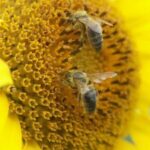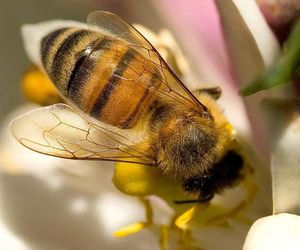Halloween and Thanksgiving wouldn’t be the same without pumpkins to carve or cook into delicious pies. Pumpkin plants have both male and female flowers. The male flowers appear first and they are more abundant. You can usually find the female flowers a week later. In order to identify them, look at the bottom of the flower where it attaches to the vine. If there is a bulge (a baby pumpkin) between the stem and the flower, that identifies the flower as a female. Bees transfer the pollen from the male flowers onto the female flowers to pollinate them, but lately the bee populations have dwindled, so often times the flowers rely on other insects to do the pollinating. The only thing they have to do is visit the male flowers and then make their way to the female flowers. When all else fails, you may have to pollinate the females on your own with a brush. For more information on how to do that, visit the website; Pumpkin Nook; How to Pollinate
Location
Choose a garden site that has the full sun exposure to grow your pumpkin patch. If you have a big space, that is perfect, but don’t worry if you don’t. Pumpkins can grow amongst your corn plants for companion planting. Another idea is to plant them beside your sidewalk where they can vine across the sidewalk or lawn. Pumpkins can also grow in 5-gallon buckets. The garden site should have full sun exposure.
Prepare the Garden Site
Remove the weeds in the garden area. Dig or till the garden area to a depth of 12 to 15-inches. Pumpkins prefer a soil that is rich and well draining, so amend the soil with 3 to 4-inches compost. This is also the time to add some manure if available. This natural fertilizer will help your pumpkins and if companion plants to grow big.
Wait until all danger of frost is past, and the soil has warmed to 60° Fahrenheit at a depth of 4 inches. Don’t plant too early, because frost will kill your pumpkin vines and you will have to start all over. If planted in cool soils, the seeds won’t germinate.
Create hills or mounds in the soil by mounding the garden soil in a 3-foot diameter circle. The soil should be 6 inches higher than the surrounding soil. Space the hills 5 to 6-feet apart in rows 10 to 15-feet apart.
Prepare the Seeds
Prepare the seeds for planting. Some gardeners simply plant the seeds in the ground, while other’s file the edges of the pumpkin seed with a nail file. They file all around the seed, but leave the pointed end alone. No matter which way you choose, help the seeds out by filling a bowl with warm water. Put the seeds in the water and leave them to soak for three to four hours. When you soak the seeds, it allows the seeds to absorb water so they can germinate. If any seeds float on top of the water, toss them away because they are no longer viable. You can try either way to see which works best for you.
Planting Pumpkin Seeds
Make a hole in the soil with your finger or a dibble. Plant the seeds with the pointed end going into the soil first or sow the seed on its side. Cover the seed hole with soil and firm the soil in place with your hands. The seeds should be 1-inch deep. Each hill should contain five or six evenly space seeds Plant five or six seeds per hill.
Watering
Water the pumpkin patch thoroughly. Continue to keep the soil evenly moist until the seeds sprout. It can take one to two weeks for the seeds to germinate. When the young seedlings are established and have their second set of true leaves, it is time to thin out the weaker plants. There should only be two to three plants per hill.
Pumpkins need water to grow and they are thirsty drinkers. The amount of water depends largely on the type of soil they are growing. Sandy soils need more frequent watering than heavier soil. When you water, do so at ground level when the soil is dry on top. For greater success, provide about an inch of water each week.
Mulch
Place a 2 to 4-inch layer of organic mulch over the soil. This helps the soil to retain moisture and it prevents weeds from growing.
Fertilizer
Feed the pumpkin plants with a high nitrogen formula fertilizer when the vines are 12 inches long. Switch the fertilizer to one that is high in phosphorous when the vines are about to flower. This usually occurs in early July or 10 weeks after the planting.
Pests
Watch for cucumber beetles and squash bugs. Pick the bugs off by hand and toss them into a bucket of hot soapy water. Spray them with liquid Rotenone/Pyrethrin. This spray is an organic blend of insecticides.
Fruit Formation
Handle the developing fruit as little as possible. If appearance is important to you and you want them round, move the pumpkin so the flower end, or bottom is on the ground.
Harvesting
Harvest the pumpkins before the heavy frosts arrive, or when the color turns deep orange and the fruit feels heavy. Using a sharp knife, sever the pumpkin off the vine, but leave a 3-inch or longer stem.
Cure the pumpkins in a warm location if you had to harvest them early in the season due to disease or other causes. Otherwise, store the pumpkins in a dry building where the temperature remains between 50° and 55° Fahrenheit.






